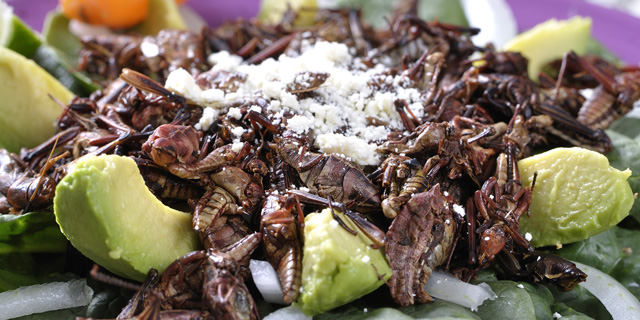Would you eat crickets? For many people living in North America the knee-jerk reaction to human entomophagy, the act of humans eating insects, is a resounding “No!”. However, the stigma towards eating bugs may erode as the buzz surrounding insects’ nutritional and environmental benefits creeps its way into popular consciousness.
In the past year alone, several organizations and studies have heralded these little critters as the “future of food” and stories of forward-thinking food start-ups with bugs on the brain have gained traction from media the world over. But why, you may ask, is this even a topic of conversation? Is there really a need for a game-changer in the food industry? Simply put, the answer is yes.
The over 1 billion chronically hungry people worldwide at this moment fuels this sense of urgency. With a boost in crop productions largely out of the question due to land scarcity and the increasing unpredictability of weather patterns, we must look to more sustainable and economically viable food resources. A report published last year by United Nations’ Food and Agriculture Organization (FAO) titled Edible Insects: Future prospects for food and feed security begins with this alarming call to arms:
“…by 2050 the world will host 9 billion people. To accommodate this number, current food production will need to almost double….To meet the food and nutrition challenges of today and tomorrow, what we eat and how we produce it needs to be re-evaluated. Inefficiencies need to be rectified and food waste reduced.”
That’s where bugs come in.
Next, how bug production can change the world… [pagebreak]
Compared to other sources of protein, insects are significantly more cost effective; according to the UN’s study, it takes roughly 25 pounds of cattle feed and 2,000 gallons of water to supply 1 pound of beef, whereas it takes a mere 1-2 pounds of feed and 1 pound of water to supply 1 pound of crickets. Aside from being cheap, these statistics also mean that the carbon emissions caused by transporting many large shipments of cattle feed could be drastically reduced if North Americans replaced even a small amount of the cattle in their diets with insects.
With regards to nutrients, insects are also pretty astonishing; each different insect provides different types of amino acids, many of which, like tryptophan (necessary for the production of serotonin) and lysine (which aids in the absorption of calcium), cannot be produced by the human body and are therefore necessary parts of our daily nutritional intake.
High and varied protein content aside, certain insects are also otherwise very nutritionally significant. Locusts, for example have twice the iron by weight than red meat and also provide us with a good amount of fiber, nutrients which are less available to impoverished communities due to the exorbitant cost of their more popular sources: meat.
Click on to find out how insects are already creeping their way in to the American diet!… [pagebreak]
Clearly, bugs have a lot to offer and people are taking notice. The newly opened Big Cricket Farms, for example, is the first (and for now, the only) farm in North America to raise bugs for human consumption.
This Ohio-based farm raises crickets in contained areas and feeds them a steady diet of organic chicken feed made from high grade vegetables and grains. These crickets are then dried and milled to create cricket flour, which is then purchased by companies.
One such Big Cricket customer is the Six Foods company, the product of a successfully funded Kickstarter campaign. Six Foods uses the milled crickets to make chips, which they’ve cleverly named “Chirps”. Currently available for pre-order in the United States and slated for official release in the fall, these chirps will be low-fat, gluten-free, contain the same amount of protein as an egg and will be available in Sea Salt, Hickory, and Aged Cheddar flavors.
Shocked? You shouldn’t be, Six Foods isn’t alone in their insect-advocacy! The United Nations estimates that insects form part of the traditional diets of well over 2 billion people worldwide, with strong bug-consuming contingents in tropical regions like Ecuador, Brazil, Colombia, Mexico, where culinary love affairs with bugs predate the arrival of the Spanish.
Next, where you can get your bug fix… [pagebreak]
The Oaxaca and Puebla regions of Mexico in particular are probably the most famous Latin American proponents of entomophagy; here chapulines and ahuahutle (among many other insects) are consumed as both street food and as haute cuisine. The popularity of regional Mexican cuisine is rapidly spreading north, with restaurants like NYC’s The Black Ant, San Francisco’s Dirty Habit, and San Diego’s Tacos Perla, all offering innovative and traditional dishes, brimming with arthropods and the like.
In so doing, these restaurants and their chefs, along with groups like Six Foods and Big Cricket, are leading the introduction of bugs into the North American diet, getting us as a country that much closer to accepting insects as potentially transformative agents in the food world.
The bottom line is: a sustainable food industry and the future depletion of the world’s hungry may rely on open-minded eating. Set aside the squeamishness, do your research, try a cricket, and see where things go from there!
For some of our buggy recipes, check out Meals Made with Insects.


![Making Mealtime Matter with La Familia: Easy Sofrito [Video]](https://thelatinkitchen.com/wp-content/uploads/2015/10/sofrito-shutterstock__0-500x383.jpg)
![Easy Latin Smoothies: Goji Berry Smoothie [Video]](https://thelatinkitchen.com/wp-content/uploads/2015/12/goji_berry-shutterstock_-500x383.jpg)
















![Fun and Fast Recipes: Fiesta Cabbage Salad [Video]](https://thelatinkitchen.com/wp-content/uploads/2015/11/fiesta_cabbage_slaw-shutterstock_-500x383.jpg)









